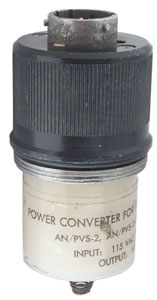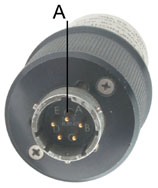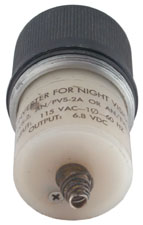TVS-2B Night Vision Scope MX-7794B
Crew Served Weapon Night Sight
© Brooke Clarke 2005 - 2008


Description
Operation
What Goes Wrong
Power
BA-1100
1100BA Battery Adapter
Battery Eliminator
Manuals
Patents
Links
Description
This is a Vietnam era Crew Served
Weapon Night Vision Device. It uses a Schmidt-
Cassegrain
optical
system. The manual says 7 power. The objective
diameter is probably 5.5 to 6 inches.
Image Intensifier
Marked: Image Intensifier, Type:
MX-7854/UV, FSN 5855-051-2702, U.S. Property, Ser. No. 17452,
8524
2.74" diameter x 7.3" long. 34mm flat exit diameter.
1.4"
dia. flat fiber optic plate.
Oscillator
Marked: Oscillator H.V.,
M?052374B(F10), Lectrospace Co., Westbury, N.Y., Contract No.,
DAARC7-69-C-032,
Ser.
No., 3922
The oscillator has a socket on it's bottom that plugs directly
into a
pin on the image intensifier.
Focus
Turning the Focus knob clockwise
moves
the main mirror back
Lens Cap - Filter
The front cover
contains a small open segment and a filter wheel with 3
neutral density filters, each more dense than the prior one as
well as
an open window. This would allow testing the scope in
the
daytime. Using the darkest filter on a cloudy day is
about the
same as no cover at night with 1/2 moon on distant hills.
Reticule
This sight is intended for use on
either the M2 .50 cal. Machine Gun (M2 rtucule) or the 106 mm
Recoilless Rifle (M40 reticule).
This on is setup with the M2 reticule and straight through
eyepiece. When the M40 reticule is used the right angle
eyepiece
is used.
The reticule gets it's electricity from a cble that goes into
the front
of the front lens element. This is not a high voltage
wire.
Operation
The switch with the pointer has 3
positions. CCW is OFF, then scope ON, then Scope and
Reticule ON.
The large knob controls objective focus and the eyepiece controls
focusing on the image intensifier tube output window.
When looking up at the stars at night there's a much larger number
of
start visible than with the naked eye. Also there is no
night
adaptation of the eye needed since the scope has a bright
output.
But you probably can see fainter stars with night adapted
eyes.
The output color is green to match the peak in a human eye's
spectral
response.
This scope was not intended to be hand held, and doing so is very
difficult. Need to figure out a way to get it mounted on a
tripod.
Upon receipt the unit appeared to be
DOA. The 1½" diameter knob on the top of the scope gives
access to the oscillator, which can simply be lifted out.
Plugging it in and removing it a few times cleaned it's contacts
and
now it's working OK. It again failed to start and cycling
the
oscillator up and down a couple of times fixed it. Maybe it
needs
cleaning with a pencil eraser?
Power
BA-1100 Battery

The
original
battery was the BA-1100/U
6135-00-926-0827 which is one of the long obsolete Mercury based
batteries. A
prior owner has made a simple battery adapter by taking a four
"AA"
battery holder where all the cells are wired in series and
attaching a
metal plate to each end. The "battery" goes into the scope
Positive (+) end first. The scope case is a negative ground.
The 4 AA battery holder has both the + and - terminals on the same
end. This adapter is made by placing a metal plate on the
terminal end with the positive contact connected to the positive
terminal and with epoxy or hot melt glue insulating the negative
contact. A diode is connected from the negative spring to
the
opposite end and goes through a small drilled hole to the negative
metal plate that is glued to insulate it from the jumper eyelets
on
that
end. Single sided PCB material would be a good material to
use
for this.
The BA-1100 used 4 Mercury cells which when fresh put out 4 * 1.35
=
5.40 Volts. When dead it was 5.0 volts.
If 4 AA rechargeable batteries were to be tried they would be
about 1.4
V * 4 = 5.6 Volts fresh and 1.2 * 4 or 4.8 when dead. So
although
they probably would work when fresh, the useful life would be
short.
If 4 AA Alkaline cells are used the fresh voltage would be 4 *
1.52 or
6.08 which is a little too hot, that's why the diode is in the
adapter
to drop the fresh voltage down to about 5.6, very close to the
Mercury
battery. The 5.0 volt dead voltage for the adapter occurs
when
the cell voltage is 1.4 so when the AA cells no longer work in
this
adapter they would still power a flashlight.
1100BA Battery Adapter

After working with the Battery Eliminator (see below) it's clear
that
6.6 Volts DC is OK so the diode used in the above battery adapter
is
really not needed and not desired since it wasts energy. The
1100BA product does not use a
diode.
The brass disk contacts have polarity (+) and (-) stamped into
them. Also the label "TVS2 cap Positive" is on the Positive
end.
Battery Eliminator
This is a battery eliminator that replaces the BA-1100/U Mercury
battery that's long obsolete. It's line powered from regular
115
VAC single phase power.

|

|

|
Power
Converter for Night Vision Sights
AN/PVS-2, AN/PVS-2A or AN/TVS-4
Input: 115 VAC single phase 60 Hz
Output: 6.8 VDC
|
MS3110P-14-5-5P
shown with pin A next to wide keyway
at top. Letters go clockwise.
|
DC
output is
case threads
and spring.
|
The A.C. cable will use a MS3116E-14-5S or MS3116F-14-5S or
MS3116P-14-5S connector.
The MS3116E-14-5S is the lowest
cost and is available from
William Perry Co.
Wiring is A.C. line to pins B and C.
Earth ground to pin E = threads on battery eliminator and
connector
shell.
Open circuit output about 6.6 Volts.
Although only three Night Vision Sights are listed on the batery
eliminator it should work for anything that uses the BA-1100/U
like the
TVS-2B.
These are available from
Mike
Murphy on his
NIGHT VISION,
SURVEILLANCE AND RELATED ITEMS web
page.
Manuals
TM 11-5855-202-10 If you have a pdf
let me know
TM 11-5855-202-23P Organizational and Direct Support
Maintenance
Repair and Special Tools Lists (Including Depot Maintenance Repair
Parts and Special Tools) For Night Vision Sight, Crew Served
Weapons
AN/TVS-2 (NSN 5855-00-087-3144), AN/TVS-2A (NSN 5855-00-791-3358)
and
AN/TVS-2B (NSN 5855-00-484-8638)
TM 11-5855-203-10
Night Vision Sight, Individual Crew Served Weapon AN/PVS-2 (NSN
5855-00-087-2947), AN/PVS-2A (5855-00-179-3708) and AN/PVS-2B
(5855-00-760-3869)
TM 11-5855-203-13 Organizational and DS Maintennance Manual, Night
Vision Sight: Crew Served Weapons Models 9927 and 9927A, April
1967
TM 11-5855-203-23P Technical Manual Organizational and Direct
Support
Maintenance Repair Parts and Special Tools Lists (Including Depot
Maintenance Repair Parts and Special Tools) for Night Vision
Sight,
Crew Served WeaponsAN/TVS-2 (NSN 5855-00-087-3144), AN/TVS-2A (NSN
5885-00-791-3358) and AN/TVS-2B (NSN 5855-00-484-8638),
November
1977 Change 1
TB 11-5800-212-24 Procedure for Determining Serviceability of
Night
Vision Sight
Individual Served Weapon Sight, Crew Served Weapon AN/PVS-2 and
AN/PVS-2A; Night Vision Sight, Crew Served Weapons AN/TVS-2B;
Night
Vision SIghts, Mimiaturized AN/PVS-3 and AN/PVS-3A; and Night
Vision
Sight, Tripod Mounted AN/TVS-4 and AN/TVS-4A.
TC 23-13 Crew-Served Weapon, Night Vision Sight, Jan 1967
Related Equipment
Night Vision Patents
3454773 BINOCULAR NIGHT TELESCOPE
WITH
SINGLE IMAGE TUBE, Bulthuis et al (NV Optische), Jul 1969,
3744872 BINOCULAR WITH IMPROVED PRISM MOUNT, Akin (Bushnell), Jul
1973,
- moulded plastic body
4030047 Opto-mechanical subsystem with temperature compensation
through
isothermal Design, F.E. Goodwin (NASA), - Beryllium
4205894 Hermetically sealed binoculars, (Bell & Howell) -
single
objective
4463252 Night vision goggle system, (Baird Corp), - single
objective
5029963 Replacement device for a driver's viewer (ITT), - upgrades
the
AN/VVS-2 to a Gen III device
5084780 Telescopic sight for day/night viewing, (ITT), - single
objective, single eyepiece, two internal paths
4822994 Small arms sight for use
during
daylight and nighttime conditions, (ITT) - removable image
intensifier
Photoelectricity and Its
Applications",
1949, John Wiley & Sons Chapter 18 Light Beam Signalling
&
Infared Detection
4629295 Night vision instrument with electronic image converter
(Simrad
Optronics A/S) - beam splitter
3509344 DEVICE WITH A NIGHT TELESCOPE (NV Optische) - two
objectives
one eyepiece
4467190 Night-vision equipment, Aug 21, 1984
4576432 Aiming or sighting apparatus with synchronously rotating
thermal imager and aiming head Mar 18, 1986
4629295 Night vision instrument with electronic image converter
Dec 16,
1986
4653879 Compact see-through night vision goggles Mar 31, 1987
4655562 Objective lens system, relay lens system, and eyepiece
lens
system for night-vision goggles Apr 7, 1987
4775217 Night vision viewing system Oct 4, 1988
4828378 Night vision viewing systems May 9, 1989
4863269 Weapon sights Sep 5, 1989
4867549 Re-imaging optical system Sep 19, 1989
5157553 Collimator for a Binocular Viewing System -
5223974 Collimator for a Binocular Viewing System -
5301060 Optical element (Minolta) - laser scanner
5347397 Diopter cell assembly for a
binocular viewing system (ITT) - splitter for single objective two
eyepiece systems
5444568 Consumer night vision viewing device
5455711 Magnification lens coupling device for a night vision
assembly
(ITT) - two adapter rings to add accy lens to NVD
5495364 Night vision binoculars (ITT) - waterproof single
objective two
eyepieces
5471374 Illuminator bracket for a night vision device (ITT) -
breaks
easily
5495364 Night vision binoculars (ITT) - waterproof single
objective two
eyepieces
5537261 Night vision binoculars (ITT) - commercial low cost single
objective two eyepiece waterproof
5595435 Flashlight illuminator for a night vision device (ITT)
-LED or
Laser Diode - fits the easily broken bracket (viewer may be the
160/260?)
5737131 Night vision monocular (ITT) -
5847868 Night vision binoculars (ITT) - single objective two
eyepieces
low cost
6069557 Automatic long-life infrared emitter & locator system
-
flashing IR LED beacon (like the one that fits a 9V battery - many
circuits
6219250 Night vision binoculars (ITT) - single objective two
eyepieces
low cost
6456497 Night vision binoculars (ITT) - single objective two
eyepieces
low cost
6570147 Color night vision apparatus (ITT) - RGB are split like
for a
TV camera, seperate Intensifiers work on the three paths where the
output phosphor is the same color as the path color and then
combined
H1599 Synthetic-color night vision - blends a visible color image
and
an IR image into a single false color image
Links
Fort Belvoir Army Night Vision
Labs
- Early Attempts
at
Night Vision Technology - 1967 - Pulse Gated I2-TVS-2 Crew
Served
Weapon Night Sight
A
History
of the United States Army Communications-Electronics Command
(CECOM) - "Second generation night vision devices (image
intensification technology)
replaced the first generation "sniper scope" (near infrared
technology) of World War II. The Small Starlight Scope AN/PVS-2, the
Crew Served
Weapons Sight AN/TVS-2, and the medium range Night Observation
Device
AN/TVS-4
all saw service in Vietnam. The Night Vision Laboratory, which was
attached to
ECOM in 1965, began their development in 1961. Production of the
AN/PVS-2 began
in 1964."
S.T.A.N.O. Components
- Night Vision dealer
Back to Brooke's PRC68, Products
for
Sale, Astronomy, CCD
Astronomy, Binoculars, Optics,
Military Information,
Personal Home
page
[an error occurred while processing this directive] page created 24 Jan.
2005.


 The
original
battery was the BA-1100/U
6135-00-926-0827 which is one of the long obsolete Mercury based
batteries. A
prior owner has made a simple battery adapter by taking a four
"AA"
battery holder where all the cells are wired in series and
attaching a
metal plate to each end. The "battery" goes into the scope
Positive (+) end first. The scope case is a negative ground.
The
original
battery was the BA-1100/U
6135-00-926-0827 which is one of the long obsolete Mercury based
batteries. A
prior owner has made a simple battery adapter by taking a four
"AA"
battery holder where all the cells are wired in series and
attaching a
metal plate to each end. The "battery" goes into the scope
Positive (+) end first. The scope case is a negative ground.